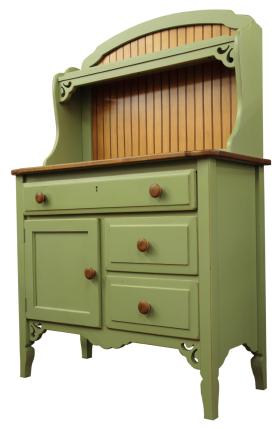Milk Paint is an Environmentally Friendly Finish that has Been around for Thousands of Years
A milk paint finish is common on antique furniture. Milk paint finishes have been used for thousands of years to add color and definition to wood furniture. It is a top finish choice because it can be found in environmentally friendly and non-toxic varieties. Pigment colors can be added to milk paint to create any desired shade.
The History of Milk Paint
There is evidence that milk paint was used thousands of years ago by cavemen. Paintings and drawings have been discovered inside of caves and tombs that were created with milk paint. The ingredients used to create milk paint are very simple which is why the substance was readily available to the earth’s earliest humans. Over the years, the ingredient list has remained relatively similar but it has become slightly more advanced. There has been a recent resurgence in the popularity of milk paint because it is known to contain all natural ingredients that are not harmful to humans, animals or the environment.
Do Milk Paints Actually Contain Milk?
For people that are not familiar with milk paint, the first thing that comes to mind when the term “milk paint” is uttered is raw milk in a jug. The first question asked is, “Can you really paint a piece of furniture with regular old milk?”
The answer to this question is: Milk paint does contain properties derived from actual milk, but utilizing milk paint to finish a piece of wood furniture is not as simple as using a paintbrush to add raw milk to the surface of the wood. Applying raw milk that is not mixed with any other ingredients does not produce the effect that can be accomplished with manufactured milk paint.
Milk Paint Ingredients
When milk paint was first invented, the typical ingredient list included milk that was curdled, powdered lime, and natural colors. Different color pigments were taken from natural items found in the environment. For example, yellow shades came from the mustard plant and orange came from properties found in soil.
Today, most companies that commercially produce milk paint follow many of the same processes that have been utilized for thousands of years. But instead of using curdled milk they use processed milk proteins. Many of the other ingredients are the same as the original formulas.
Milk Paint Comes in a Powder Form
Mixing milk paint is simple. It comes in a powdered form and the only ingredient that must be added is water. Users can control the amount of water they wish to add to the powder. This allows for personal preference when it comes to the thickness of the paint. Some like to use a thin layer of milk paint on furniture to achieve a white washed look. Others like a thicker coating of paint and therefore they add less water to the mixture. Different colored milk paint mixtures can be combined together to create any desired color.
Benefits of Milk Paint
It is easy to milk paint furniture. But, besides its ease of use, the paint also has several other advantages:
- It can be applied quickly.
- It does not chip when it is dry.
- It develops a nice sheen over time.
- It is simple to mix.
- It does not emit any types of toxic fumes during the application process.
- It is easy to clean up.

